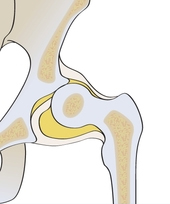Main Causes of Hip Subluxation in Children with Cerebral Palsy & its Treatment Procedure

In children with cerebral palsy, the hip is normal at birth but the effects of delayed motor development lead to dysplasia. The asymmetrical activity of the muscles surrounding the hip and lack of load-bearing affect bone development are the main causes of subluxation and dislocation
Hip displacement refers to the gradual lateral displacement of the femoral head from under the acetabulum, and it is defined by Migration Percentage (MP). MP is calculated by dividing the width of the femoral head outside the lateral margin of the acetabulum A by the total width of the head of the femur B.
Hip subluxation is defined by MP between 10% and 99%. Hip dislocation is defined when MP is 100%.
Lack of weight-bearing and asymmetry inactivity of muscles around hip because of spasticity and muscle imbalances which lead to pain, degeneration of articular cartilage, limited range of motion, difficulty in functioning hygiene, and personal care
Recently a scale was developed to describe hip morphology in adolescents with CP
- I – Normal hip with MP < 10%
- II – Near normal hip with MP ≥ 10% ≤ 15%
- III – Dysplastic hip with MP > 15% ≤ 30%
- IV – Subluxated hip with MP ≥ 30% < 100%
- V – Dislocated hip with MP ≥ 100%
- VI – Salvage Surgery
Treatment includes Postural management, orthosis, tone management, and surgery, prone positioning is very useful after birth during play activities, sitting, and standing in hip abduction. SWASH brace helps in positioning
Check out these links for
relevant information: Neurological physiotherapy, paediatric neuro.
For more details contact
us on 📞9618906780
